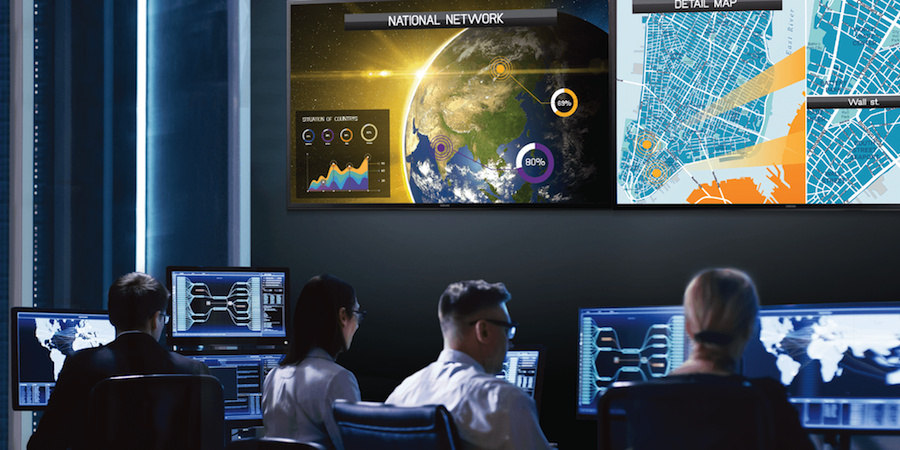For state and local governments that have a tough time hiring and retaining technical staff, there have been welcome advances in the world of control room design. The evolution of LED video monitors ensures control room staff enjoy sharp, crisp video in emergencies where fuzzy imagery could have life-or-death consequences.
And thanks to a new generation of all-in-one LED screens, building a public safety dispatch center is getting a lot less complicated. All-in-one LED screens require no peripherals because the speakers are built in. The control box is integrated into the screen structure, so there’s one less device cluttering a dispatch center design.
It’s getting much easier for state and local governments to install wall-sized screens in dispatch centers, transit agency control rooms and other sites that require real-time video feeds.
Understanding the value of all-in-one LED video screens
When a suburban city in the U.S. Sun Belt needs a new 911 dispatch center for its growing population or a state in the Mountain West needs to replace an aging wall-sized monitor in its transportation control room, advances in LED video technology have created immense opportunities for these and other state and local governments to achieve modern control room design. LED video feeds feature rich colors and strong contrasts that are essential for viewing from, say, 10 or more feet away.
For all these benefits, however, big-screen installation and management traditionally tended toward clunky and complicated. An unsightly controller box could dangle below a big screen. It might take all day to install and configure a new screen.
The new All-in-One LED IAC series from Samsung illustrates why a new generation of screens is attractive for state and local government:
- Fast installation. Samsung’s Quick Build Structure uses a simple mounting system made up of two background plates and four preset modules. Result: a top-of-the-line, 130-inch monitor can be up and running in two hours.
- Automated configuration. There’s no need to mount a control box in a cabinet or on a wall because the controller is integrated into the screen design.
- No peripherals. Speakers along the bottom of the screen provide all the sound effects a control room might need.
The speed and simplicity help in-house agency technical staff quickly attend to other responsibilities once the screen is installed.
Moreover, AI algorithms that analyze video pixels can add subtle tweaks to live video displays on an all-in-one LED monitor. Noise reduction removes distortion and clarifies imagery. Low-level gray correction helps details stand out more clearly. Color revision helps bright hues stand out.
LED enhancement technologies can make just about any visual look like a high dynamic range (HDR) image. For instance, Samsung uses a technique called Dynamic Peaking that analyzes every frame of a live video feed while managing the screen’s energy consumption. This helps create eye-catching imagery while keeping a lid on electricity demand.
Integrate digital signage in the control room
Streamline mission-critical workflows and content management with secure, large-format displays. Download Now
LED basics: What state and local leaders need to know
LED is short for light-emitting diode. LEDs provide a large volume of bright light without consuming much electricity, which makes them a great option in any illuminated device, from a coal miner’s headlamp to a jumbo screen in Tokyo or Times Square.
LED is an excellent light source for giant screen monitors because the imagery is seamless. In a control room, operators can put images in any area of the screen without worrying about horizontal or vertical lines bisecting the scene.
This freedom to put pixels wherever they might be needed means LED screens can take unusual shapes, with rounded corners or curved designs. Samsung’s microLED technology is a specialized application designed to bring extremely realistic imagery to giant-screen applications.
What about LCD screens?
LCD, or liquid crystal display, has a place in the world of video because it provides incredibly high resolution like 8K. LCD displays are also relatively inexpensive, which is attractive for organizations that need to buy a large quantity of screens.
The question for state or local government control room designers is whether they would need all this resolution. If people are sitting more than 10 feet from the screen, there might not be much use for extreme-detail LCD imagery.
What is ‘pixel pitch’ and why does it matter?
Computers convert images into digital dots, or pixels, for display on a screen. Pitch — usually measured in millimeters — is the distance between each pixel. A smaller pitch means more pixels are packed into the same space, which implies higher resolution. Thus, a monitor with a pixel pitch of .5mm would produce much finer detail than a monitor with a 2.5mm pixel pitch.
Keep in mind, however, that the viewer’s distance from the screen has a strong impact on the viewing experience. People in a control room 20 feet from the screen do not require nearly as much pixel density as people sitting 18 inches from their personal computer monitor. This point becomes clear in the Samsung All-In-One IAC series, which has a pixel pitch of 1.5mm.
Security and privacy details that can’t be overlooked
Samsung developed a service called MagicINFO for device and content management that keeps data away from the prying eyes of hackers and cybercriminals. MagicINFO follows the ISO 27701 certification, the international standard for a privacy information management system.
This is a big plus for state and local government leaders who are strapped for cybersecurity skills. MagicINFO lets control room managers use whatever combination of LED and LCD screens they need to get their work done, while always following accepted security standards.
How do LEDs perform on smaller monitors?
Government agencies building new control rooms or renovating old ones will probably be buying new video screens for PCs and other smaller form factors. Samsung’s high-resolution ViewFinity screens are a good fit for control room operations.
These LED screens have anti-glare technology, a broad color spectrum and vivid colors that people like graphic designers and architects rely on for accurate image reproduction. The staff of a control room for a state or local government agency should have similar image quality for their mission-critical tasks.
Learn more about the Samsung All-in-One LED IAC. And get our free guide with everything you need to know to initiate your LED digital signage deployment.









